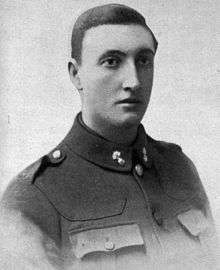Samuel Forsyth
This article deals with the New Zealand soldier. For the South Australian minister of religion see Samuel Forsyth (Methodist)
| Samuel Forsyth VC | |
|---|---|
 Sergeant Samuel Forsyth, 1918. | |
| Born |
3 April 1891 Wellington, New Zealand |
| Died |
24 August 1918 (aged 27) † Grévillers, France |
| Buried at | Adanac Military Cemetery, France |
| Allegiance |
|
| Service/branch |
|
| Years of service | 1914–1918 |
| Rank | Sergeant |
| Unit | New Zealand Engineers |
| Battles/wars |
First World War |
| Awards |
|
Samuel Forsyth VC (1891–1918) was a non-commissioned officer in the New Zealand Military Forces who served with the New Zealand Expeditionary Force during the First World War. He participated in the Gallipoli Campaign and later on the Western Front. He was a posthumous recipient of the Victoria Cross, the highest award of the British Commonwealth for gallantry "in the face of the enemy".
Early life
Samuel Forsyth was born in Wellington, New Zealand on 3 April 1891.[1] His father, Thomas Forsyth of Thorndon, was a nightwatchman on the SS Maori.[2] He attended Thorndon School, and later Terrace School, and after completing his education, found employment as a gold amalgamator. He was a volunteer with the Sailor's Friend Society and was also served in the Territorial Force.[1][3]
Military career
Forsyth enlisted in the New Zealand Expeditionary Force and embarked for the Middle East in October 1914 with the Field Engineers.[1] He served at Gallipoli during the campaign there in 1915, and was medically evacuated twice. By 1918, he had been promoted to sergeant in the New Zealand Engineers.[4]
Forsyth was on temporary attachment to 2nd Battalion, Auckland Infantry Regiment during the early stages of the Hundred Days Offensive. He was on probation for a commission in his own unit and his attachment to the battalion was in order to gain front line experience. On 24 August 1918, the battalion was tasked with the capture of the village of Grévillers. On reaching the outskirts of the village, German machine gun fire prevented any further forward movement. Forsyth, scouting ahead of his platoon, then performed the actions which led to his posthumous award of the Victoria Cross.[4]
The citation for Forsyth's Victoria Cross read as follows:
For most conspicuous bravery and devotion to duty in attack. On nearing the objective, his company came under heavy machine-gun fire. Through Serjt. Forsyth's dashing leadership and total disregard of danger, three machine-gun positions were rushed and the crews taken prisoner before they could inflict many casualties on our troops. During subsequent advance his company came under heavy fire from several machine guns, two of which he located by a daring reconnaissance. In his endeavour to gain support from a Tank, he was wounded, but after having the wound bandaged, he again got in touch with the Tank, which in the face of very heavy fire from machine guns and anti-Tank guns, he endeavoured to lead with magnificent coolness to a favourable position. The Tank, however, was put out of action. Serjt. Forsyth then organised the Tank crew and several of his men into a section, and led them to a position where the machine guns could be outflanked. Always under heavy fire, he directed them into positions which brought about a retirement of the enemy machine guns and enabled the advance to continue. This gallant N.C.O. was at that moment killed by a sniper. From the commencement of the attack until the time of his death Serjt. Forsyth's courage and coolness, combined with great power of initiative proved an invaluable incentive to all who were with him and he undoubtedly saved many casualties among his comrades.— The London Gazette, No. 30967, 18 October 1918[5]
Killed while establishing a line of defence, Forsyth's actions were instrumental to the capture of Grévillers.[4] He is one of 70 New Zealanders buried at Adanac Military Cemetery, near Miraumont in France.[6][7] A memorial tablet was erected in his honour at the premises of the Sailor's Friend Society in Wellington.[3]
Medal
Forsyth's wife, Mary, was presented with the Victoria Cross by King George V. Following her death, the medal was made part of an American collection of medals. It was later sold in 1982 to a collector in Melbourne, Australia.[4]
Notes
- 1 2 3 "Sergeant Samuel Forsyth". Auckland War Memorial Museum Cenotaph Database. Retrieved 2012-11-28.
- ↑ "All Sorts of People". New Zealand Free Lance. XVIII (957). 14 November 1918. p. 4. Retrieved 19 April 2015.
- 1 2 "In Memoriam". Evening Post. 27 January 1919.
- 1 2 3 4 Harper & Richardson 2007, pp. 164–165.
- ↑ The London Gazette: (Supplement) no. 30967. pp. 12487–12488. 18 October 1918. Retrieved 5 May 2015.
- ↑ McGibbon 2001, p. 61.
- ↑ "Forsyth, Samuel". Commonwealth War Graves Commission. Retrieved 2012-11-28.
References
- Harper, Glyn; Richardson, Colin (2007). In the Face of the Enemy: The Complete History of the Victoria Cross and New Zealand. Auckland, New Zealand: HarperCollins Publishers (New Zealand) Limited. ISBN 1869506502.
- McGibbon, Ian (2001). New Zealand Battlefields and Memorials of the Western Front. Auckland, New Zealand: Oxford University Press. ISBN 0-19-558444-9.
External links
- New Zealand Troops who have won the Victoria Cross at the Wayback Machine (archived October 26, 2009) (brief biography details)
- Samuel Forsyth at Find a Grave